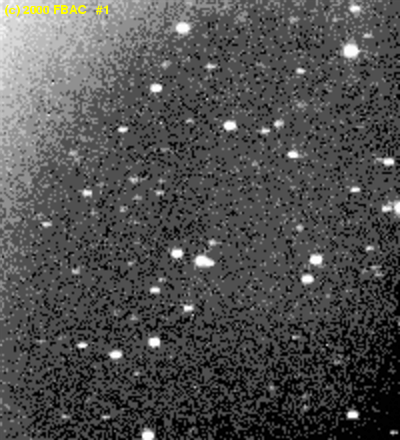
In the Fort Bend Astronomy Club is a group of people calling themselves the A-Team. For fun, we discover asteroids using the club's 18-inch Newtonian reflector, located in the East Dome at the George Observatory, which is located inside Brazos Bend State Park.
Below are our discovery images for asteroid 2000 CB41.
To discover asteroids, we take 3 images, with about an hour between exposures. (This gives the asteroids time to move.) A real asteroid, as opposed to just noise in the camera (ours is a ``Cookbook CCD'') is recognizable by the following properties:
There are two asteroids in the image below. Can you find them?
The bright one is a known asteroid, 5618 Saitama. We took these images because Saitama was in need of observations to refine its orbit.
For our good deed we were rewarded with a discovery of a new (much dimmer) unknown asteroid that just happened to be passing nearby. The minor planet center later gave it the provisional designation 2000 CB41.
Don't be fooled by the minor differences between the images: The telescope and camera never perform exactly the same way twice, so every image is a little bit different, even if nothing is changing!

Stare at this long enough and you'll start imagining asteroids everywhere! Give up?
Saitama turned out to be a doubly lucky asteroid for us. Following up on 2000 CB41 three weeks later, we discovered asteroid 2000 DP7 the same serendipitous way! (But, we weren't able to follow it for long enough, and now it's been lost again.)
It is true that these days the sky is increasingly being patrolled by asteroid-searching robots. The robots provide stiff competition for amateurs: about half the time they scoop us on our discoveries! However, such automated searches can't (yet) replace the human brain. A human being is much more likely to notice something ``funny''... and that is often how the most interesting discoveries begin.
So far all of our discoveries have been ``boring main-belt asteroids'', although we have had some ``close calls''. However, to find a single noteworthy object (such as an earth-crossing asteroid) you will almost certainly have to find a lot of ``boring'' ones first. And every ``boring'' object has its own story to tell. Some of them may actually be very, very interesting, and we just haven't realized it yet.
After all, a distant astronomer would certainly begin by classifying our sun as ``another boring yellow-dwarf star''.
Of course, given current predictions of the incredible damage that an asteroid hitting Earth could cause, the more eyes scrutinizing the skies for dangerous asteroids the better. Even quite ``small'' impacts, of the kind that happen every few years somewhere on Earth, are scary enough. And there is ample evidence of asteroids hitting the Earth in the geological past. Research is ongoing into the relationship between the size and velocity of the impacting asteroid and the size and properties of the resulting crater.
Here is a current list of named asteroids. It appears that people can get rather carried away when an asteroid is named after them. Some people even attach cosmic significance to asteroids with names!